World Vision (Federal Way, Wash.) speakers at a luncheon hosted by the Federal Water Quality Association (Washington, D.C.) on April 12 challenged attending water industry professionals to use their background and knowledge to help countries in need.
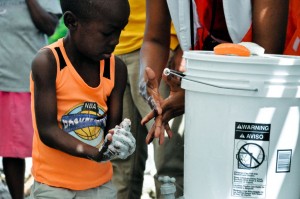
World Vision (Federal Way, Wash.) demonstrates the importance of handwashing to a young boy from camp Haut la Grotte in Haiti. Photo courtesy Lisa Salyer, World Vision. Click for larger image.
“Your work, your knowledge can help transform the life [of those] in poorer countries,” said speaker Issa Bitang A Tiati, a World Vision country program manager for Haiti. Attendees gathered to learn about World Vision’s efforts to improve access to clean water and adequate sanitation and hygiene in Haiti. Bitang A Tiati asked attendees to think of ways their knowledge can serve those without basic necessities.
Responding to local needs
World Vision responds to natural disasters, working with children, families, and their communities not only to provide for immediate needs but also to address the underlying sources of insufficient resources. Inadequate access to clean water, food, and education are visible manifestations of poverty, said speaker John Hasse, senior director of World Vision’s Latin America and Caribbean International Programs Group.
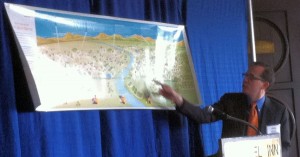
John Hasse, senior director of World Vision’s Latin America and Caribbean International Programs Group, talks about World Vision's work to improve quality of life in developing countries. WEF photo/ Jennifer Fulcher.
“[The organization] takes a holistic view of a child, and a family, and a community and then invests in them over a long period of time,” Hasse said. It works to build trust in communities, “helping them identify what their needs are,” he said. Then it helps local governments and citizens implement solutions that communities can sustain without additional help.
Many solutions start with ensuring a source of clean and accessible water, because health and security rely on water, Hasse explained. The organization also builds latrines and sanitary wash stations, and educates locals on how to use them and their importance, Hasse said.
Operations in Haiti go back to the basics
Even though the organization has worked in Haiti for more than 30 years, the 7.0-magnitude earthquake in January 2010 caused a major setback in restoration efforts. World Vision had to switch to emergency response and recovery.
The organization provided clean water, erected latrines, and improved existing toilets in displacement camps. Then, it built new showers, started mosquito and trash control efforts, and organized partnerships with the government and communities to construct and rehabilitate catchment areas and drill wells to improve water and sanitation.
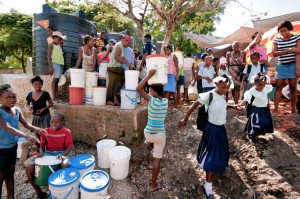
World Vision delivers chlorinated water to thousands of displaced earthquake victims in Port-Au-Prince, Haiti. Victims included residents of Parc Accra, one of the makeshift camps that housed more than 1 million people rendered homeless by the earthquake that struck Haiti on January 12, 2010. Photo courtesy of Jon Warren/World Vision
When cholera began spreading in October 2010, the organization installed hand-washing stations; distributed soap, water purification tablets, and water filtration systems; disinfected houses with cholera; and educated people on cholera prevention.
Now, the organization has begun to implement long-term solutions to ensure adequate water, sanitation, and hygiene. “We want to see the government of Haiti really be able to take ownership of meeting the needs of their own constituents,” Hasse said. “We work with the government, contribute to their own capacity, and act as a resource to them.”
“In some contexts, we need to go back to the basics,” Bitang A Tiati said. Haiti faces a 16% child mortality rate because of waterborne diseases, environmental degradation, and a barrage of natural disasters. Nearly half of the Haitian population lacks access to clean drinking water and adequate sanitation. A majority of the population lives on less than $1 a day, making food a priority over clean water and proper sanitation, he said.
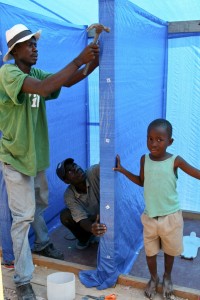
Bou Brun, 7, watches as carpenters use tarpaulins to create walls around the latrines constructed by World Vision in a displacement camp in Port-au-Prince. Photo courtesy of Madeline Wilson, World Vision. Click for larger image.
As citizens search for jobs and services, they move into cities. This increases urban populations and the stress on already overburdened systems. “Water and sanitation pose a lot of difficulty in urban centers,” Bitang A Tiati said.
“No city in Haiti has a functioning sewer system,” Bitang A Tiati said. “Waste disposal is very chaotic, especially in Port-au-Prince.” Exposure to solid and fecal waste increases the spread of disease, but digging new systems in an overcrowded city requires displacing people, which amplifies existing problems, he explained.
“We need to start looking for long-term waste management,” Bitang A Tiati said. Currently, both the government and outside agencies are presenting immediate solutions for problems but lack a long-term outlook. This shortsightedness stems mainly from a lack of funding, he said.
And funding needs are increasing. In 2008, Haiti needed $6.5 million for water and wastewater infrastructure, but after the earthquake, Haiti now needs $238 million for infrastructure, he said.
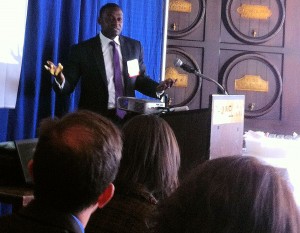
Issa Bitang A Tiati, World Vision country program manager for Haiti, discusses the lack of clean water, sanitation, and hygiene in Haiti. WEF photo/Jennifer Fulcher. Click for larger image.
Bitang A Tiati explained that technical solutions responsive to the physical, social, and cultural needs of Haitian people will provide long-term success. These solutions must come from a partnership in which others provide knowledge and innovative ideas to Haiti, so that the citizens can take over and work to support and provide for themselves, he said.
— Jennifer Fulcher, WEF Highlights








June 2, 2012
Featured, Participate, Technologies